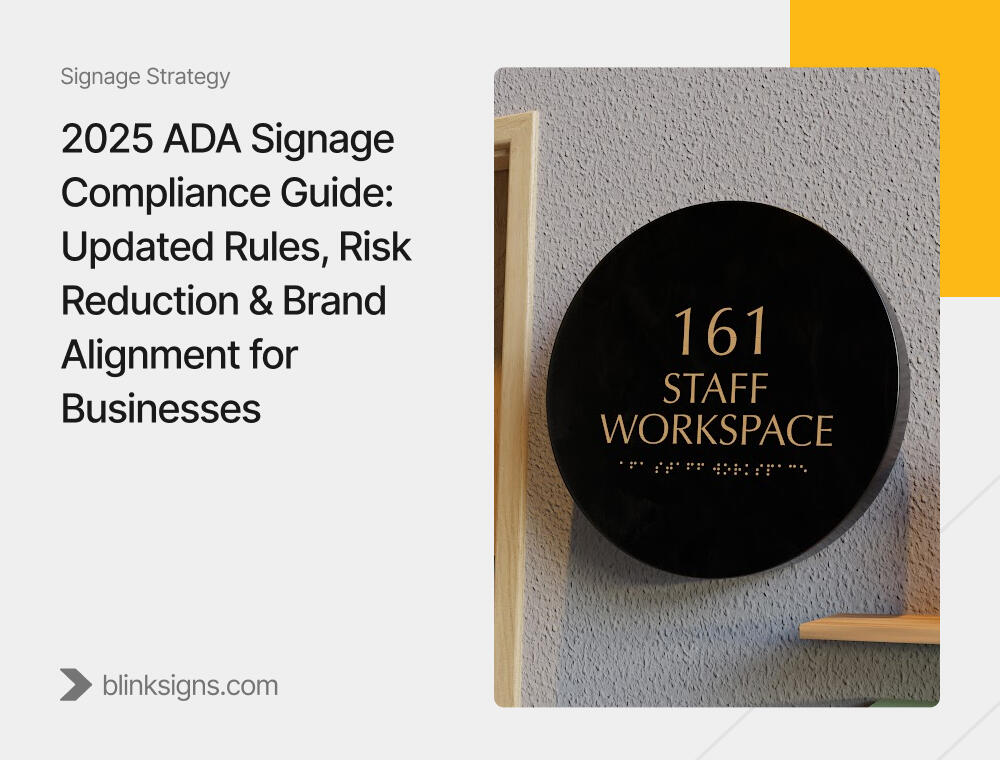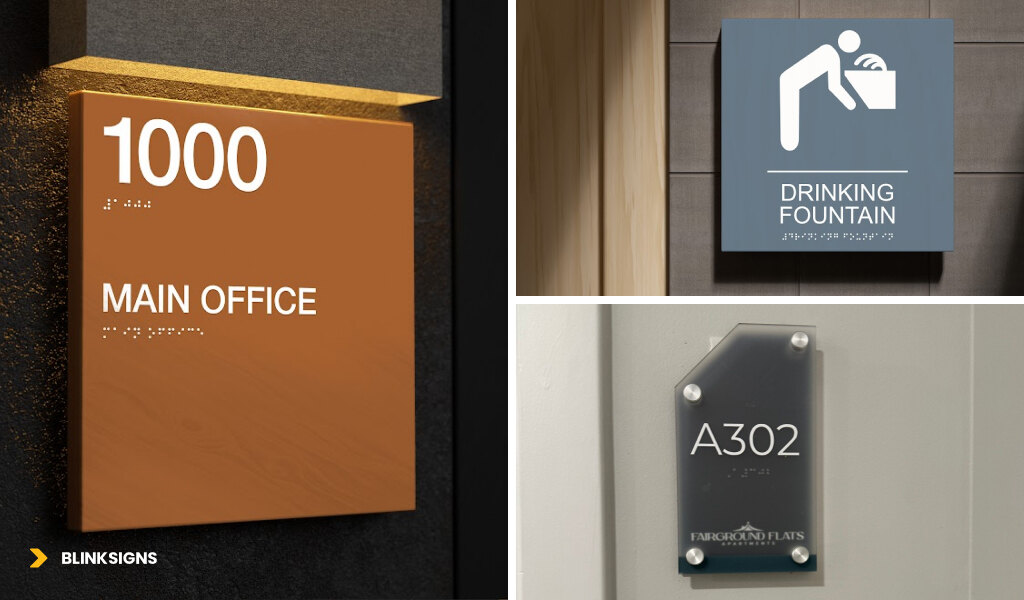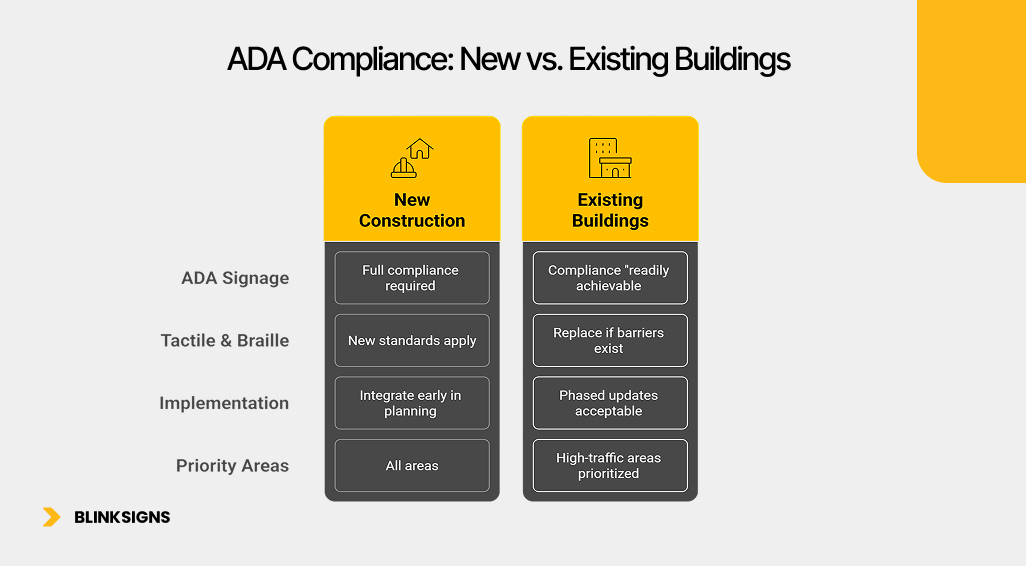
2025 ADA Signage Compliance Guide: Updated Rules, Risk Reduction & Brand Alignment for Businesses
Understanding ADA Signage Standards: What Every Business Needs to Know
Regarding public-facing environments, the Americans with Disabilities Act (ADA) isn’t just a guideline—it’s a legal and ethical responsibility. Business owners, facility managers, and developers must ensure signage is visible and accessible to all individuals, regardless of ability.
At BlinkSigns, we see ADA Signage compliance as more than a checkbox. It’s a chance to strengthen your brand’s reputation, improve customer experiences, and eliminate legal risks before they ever arise.
ADA Standards for Accessible Design
The 2010 ADA Standards for Accessible Design remain the foundation, but in 2025, new updates emphasize clarity, inclusivity, and neurodiverse-friendly design. These standards apply to permanent interior and exterior signs, especially identifying rooms and routes or conveying safety information.
Why Accessibility Matters for Business Growth
ADA-compliant signage isn’t just about legal protection. It:
- Increases customer trust and brand credibility
- Demonstrates social responsibility
- Enhances user experience for all demographics
- Future-proofs your business against evolving compliance standards
Non-compliance isn’t just risky. It can lead to fines, lawsuits, and irreversible brand damage.
Legal Risks of Non-Compliance in 2025
With more proactive enforcement, businesses face steeper fines and faster litigation timelines. ADA signage violations can lead to:
- Costly lawsuits from advocacy groups
- Insurance complications
- Construction delays and failed inspections
Mitigating these risks starts with proactive signage planning.
What’s New in 2025: Critical ADA Signage Updates You Can’t Miss

ADA Complaint Signage
ADA standards continue to evolve to meet the needs of an inclusive society. The 2025 updates introduce technical refinements and broader design philosophies that promote universal accessibility.
Enhanced Contrast & Readability Standards
- Minimum contrast ratios are now strictly enforced for both interior and exterior signs.
- Backgrounds must be non-glare, with matte or satin finishes.
- Character colors must provide a clear visual distinction from their background materials.
Updates to Braille and Tactile Lettering Rules
- Braille must now use the Grade 2 contracted format.
- Raised characters must be uppercase, sans serif, and follow updated height and spacing rules.
- Tactile characters must have rounded edges and be placed at consistent heights.
New Emergency Signage & Safety Requirements
- Emergency exit signs must now include both visual and tactile information.
- Safety signs in multi-occupancy buildings require photoluminescent or LED backlit support for visibility in low-light conditions.
- All emergency signs must be installed at accessible viewing angles and not obstructed by furniture or fixtures.
Inclusive Design for Neurodiverse & Differently Abled Users
- Signage now must consider readability factors such as symbol simplicity, clean font use, and intuitive placement.
- Directional and wayfinding signs should avoid excessive text and provide clear iconography.
- Multi-sensory indicators (e.g., sound, color coding) are encouraged to assist diverse users.
Sign Types That Must Meet ADA Standards in 2025

Sign Types That Must Meet ADA Standards in 2025
Not every sign requires full ADA compliance, but the following must adhere strictly to the 2025 updates:
- Room Identification Signs: Offices, restrooms, conference rooms, etc.
- Wayfinding Signage: Arrows, directional paths, and facility maps.
- Emergency and Exit Signs: With tactile and visual instructions.
- Safety Signage: Warnings, hazard notices, and fire instructions.
- Informational Signs: Parking, elevators, and public access notices.
Signs used for temporary messaging (e.g., menus, event notices) are generally exempt but should still follow accessibility best practices when possible.
Mounting Requirements and Spatial Accessibility Guidelines
Correct mounting location and height are as critical as tactile and Braille features. Inaccessible signage—no matter how well-designed—is non-compliant.
Standard Mounting Heights
| Sign Type | Mounting Height (from floor) | Details |
| Room ID & Nameplates | 48” to 60” | Measured to the baseline of the lowest tactile character |
| Directional / Informational Signs | Varies | Must be placed in accessible viewing areas, usually between 40”–70”, depending on content |
| Elevator / Emergency Signs | 60” center height | Consistent placement ensures universal visibility |
These standards are designed to accommodate wheelchair users and individuals with visual impairments, ensuring that all visitors can independently access the environment.
Navigating New Construction vs. Existing Facility Requirements
2025 ADA updates reinforce the distinction between new builds and existing sites, offering businesses clarity on their responsibilities:

ADA Compliance_ New vs. Existing Buildings
New Construction & Renovation Projects
- Must fully comply with all updated ADA signage specifications.
- This includes new tactile size standards, Grade 2 Braille placement, and enhanced contrast ratios.
- Design plans should integrate ADA signage early in the architectural planning phase.
Existing Buildings & Retrofitting
- Compliance must be met where it is “readily achievable”, according to DOJ guidelines.
- Older signs should be replaced if they present barriers to accessibility.
- Updates can often be phased, but high-traffic areas (entrances, restrooms, elevators) must be prioritized.
What Counts as “Readily Achievable”?
It means implementing changes without significant difficulty or expense relative to the size and resources of the business. BlinkSigns helps assess this threshold for every client.
ADA Signage Compliance by Industry: What’s Required and Why It Matters
Different industries have varying obligations, but accessibility is no longer optional—it’s a business expectation and legal mandate.
| Industry | ADA Signage Needs | Consequences of Non-Compliance |
| Retail | Entry/exit signs, restrooms, fitting rooms, directional signage | Fines, lawsuits, lost foot traffic |
| Hospitality | Room numbers, elevator signs, conference areas, ADA rooms | Poor reviews, ADA lawsuits, and regulatory audits |
| Healthcare | Department names, waiting areas, emergency exits, restrooms | HIPAA + ADA enforcement, patient confusion |
| Education | Classroom identifiers, dorm rooms, accessibility routes, and evacuation plans | DOJ oversight, funding risk for public schools |
| Offices & Corporates | Room IDs, conference spaces, employee areas, ADA-compliant wayfinding | Employee complaints, EEOC actions |
How BlinkSigns Supports Your Business in ADA Signage Compliance
At BlinkSigns, we approach ADA compliance as a core part of your brand integrity—not a checklist. Our team ensures your signage is legally compliant, professionally designed, and seamlessly integrated into your facility.
✅ Our End-to-End ADA Signage Program Includes:
- Accessibility Site Survey
A professional walkthrough of your site to identify gaps and required signage upgrades. - Regulatory Guidance & Permitting
We interpret and implement Section 216 of the ADA Standards, local codes, and zoning mandates. - Expert Design & Fabrication
Our signs feature non-glare finishes, tactile lettering, Grade 2 Braille, and high-contrast visuals—customized to your brand colors and architecture. - Professional Installation
We guarantee signage is mounted at the correct height and location per federal and state law. - Ongoing Maintenance & Updates
As standards evolve, we offer upgrade paths to maintain compliance year after year.
ADA Signage Compliance FAQs
Q1: What are the updated ADA signage requirements for 2025?
A: The 2025 updates include stricter standards for tactile lettering size, Braille positioning, contrast ratios, and sign mounting height. Digital integration and inclusive design principles are also emphasized.
Q2: Are Braille signs required for all rooms in a business?
A: No. Braille and tactile signage are only required for permanent rooms or spaces (restrooms, offices, conference rooms). Temporary signs or directional signs do not need Braille unless specified.
Q3: How do I know if my signage is ADA compliant?
A: A professional signage audit or ADA accessibility assessment—like those offered by BlinkSigns—can evaluate your current signage against 2025 standards and recommend necessary changes.
Q4: What happens if a business doesn’t comply with ADA signage laws?
A: Non-compliance may result in federal fines, civil lawsuits, and negative press. Businesses may also face operational shutdowns until corrective actions are taken.
Q5: Does ADA signage need to match brand colors and design?
A: Yes—as long as contrast, tactile requirements, and legibility are maintained, your ADA signs can reflect your brand identity. BlinkSigns specializes in designing ADA-compliant signage that complements your visual style.
Final Thoughts: Compliant Signage Builds Trust & Reputation
2025 ADA updates aren’t just about rules—they’re about building environments everyone can navigate safely and confidently. When businesses commit to accessible signage, they demonstrate responsibility, professionalism, and respect.
BlinkSigns helps you future-proof your business signage by meeting updated federal mandates and elevating your entire customer experience.
📩 Need guidance? Our ADA compliance team is ready to walk you through it—step by step.